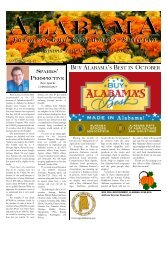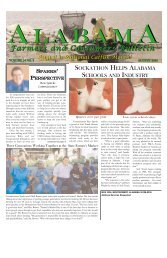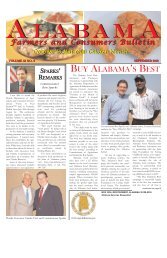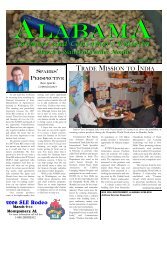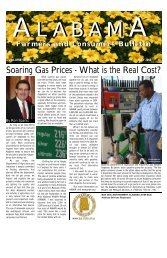Lessons Learned from Rural Schools - Alabama Department of ...
Lessons Learned from Rural Schools - Alabama Department of ...
Lessons Learned from Rural Schools - Alabama Department of ...
Create successful ePaper yourself
Turn your PDF publications into a flip-book with our unique Google optimized e-Paper software.
LLS-0010 <strong>Lessons</strong> <strong>Learned</strong>_Pub.qrk: 4/25/09 3:02 PM Page 11<br />
Education is More<br />
Than Paper & Pencils<br />
By Larry Lee<br />
It’s easy to understand why the city <strong>of</strong> Auburn has<br />
an excellent school system. After all, education is<br />
the economy there. For example, while 21 percent<br />
<strong>of</strong> all the people 25 years or older in the state have a<br />
college degree, 56 percent <strong>of</strong> those in Auburn do.<br />
In other words, the Auburn community has a strong<br />
education foundation where staying in school and going<br />
to college is not an option--it is expected. It’s no wonder<br />
that only seven other school systems provide more<br />
local funding per student that Auburn does.<br />
But Arley ain’t Auburn.<br />
Nor is it Dutton, Phil Campbell, Fruithurst, Marion,<br />
Pine Hill, Lockhart, Huxford, Gilbertown or<br />
Mount Vernon.<br />
Which makes the success <strong>of</strong> their schools all the<br />
more impressive.<br />
In the opinion <strong>of</strong> many education leaders, what<br />
happens outside the classroom in the form <strong>of</strong> “community<br />
involvement” may be as important as what<br />
goes on in the classroom.<br />
But “involvement” is greatly impacted by “community.”<br />
Or maybe we should say the circumstances surrounding<br />
the community. Wrights Mill Road<br />
Elementary in Auburn has had 100 percent participation<br />
in PTA for the last 21 years. This is a school <strong>of</strong><br />
421 students. By comparison, the PTO <strong>of</strong> one <strong>of</strong> the<br />
schools in this study (with a few students more than<br />
Wrights Mill Road) has only 12 members.<br />
But if it’s commonplace for someone in a rural<br />
community to drive an hour to work each day, then<br />
the time left over to go to PTO meetings--or to work<br />
with a child on homework--is limited.<br />
So what might be considered community involvement<br />
in one place might be something far different in<br />
another place. It’s all about understanding that resources<br />
in rural communities are much scarcer than in<br />
larger communities.<br />
It has nothing to do with the desire <strong>of</strong> parents to see<br />
that their children succeed or the hope <strong>of</strong> a local<br />
<strong>Lessons</strong> <strong>Learned</strong> <strong>from</strong> <strong>Rural</strong> <strong>Schools</strong> – May 2009<br />
mayor that their school will provide an excellent education.<br />
In fact, it’s rather remarkable that some <strong>of</strong><br />
these communities provide as much support as<br />
they do.<br />
At Huxford Elementary, the PTO pays the monthly<br />
rent on <strong>of</strong>fice equipment, buys <strong>of</strong>fice supplies and<br />
raised $34,000 for playground equipment. The Dutton<br />
School PTO bought a $4,000 laminator and lockers<br />
for the middle school. In Phil Campbell, a PTO<br />
with only a handful <strong>of</strong> members raises about $10,000<br />
annually. They have bought chairs for classrooms, put<br />
in heating and air conditioning and built a snack area.<br />
And while getting your arms around something<br />
as intangible as “community involvement” is like trying<br />
to grasp a handful <strong>of</strong> morning mist, it is obvious<br />
that all <strong>of</strong> these schools work to encourage support<br />
<strong>from</strong> both the community at-large and the parents<br />
<strong>of</strong> students.<br />
“One thing is certain,” says Jacqui James, principal<br />
at Southern Choctaw Elementary in Gilbertown, “we<br />
need community support.”<br />
Here are some <strong>of</strong> the guiding principles these ten<br />
schools focus on in building support:<br />
Create a culture <strong>of</strong> expectations<br />
Visit one <strong>of</strong> these schools and it doesn’t take long to<br />
realize that “there is something in the air” at each <strong>of</strong><br />
them. You discover this in many ways, <strong>from</strong> how clean<br />
bathrooms are, to colorful posters lining the hallways,<br />
to a cheery greeting <strong>from</strong> <strong>of</strong>fice staff, to smiles on the<br />
faces <strong>of</strong> first-graders lined up to go to lunch.<br />
Then you come to understand that central to all <strong>of</strong><br />
these outward signs is a culture <strong>of</strong> expectations for<br />
both students and staff.<br />
“Our mission,” says one principal, “is to teach our<br />
students--and not just math or reading or science.<br />
We also teach discipline, responsibility, how to treat<br />
one another, right <strong>from</strong> wrong and to do the best that<br />
you can.”<br />
This is explained to some degree by the findings<br />
<strong>of</strong> Gerald Carter that the majority <strong>of</strong> teachers in<br />
11



